Price: Starts from ₹ 92,400
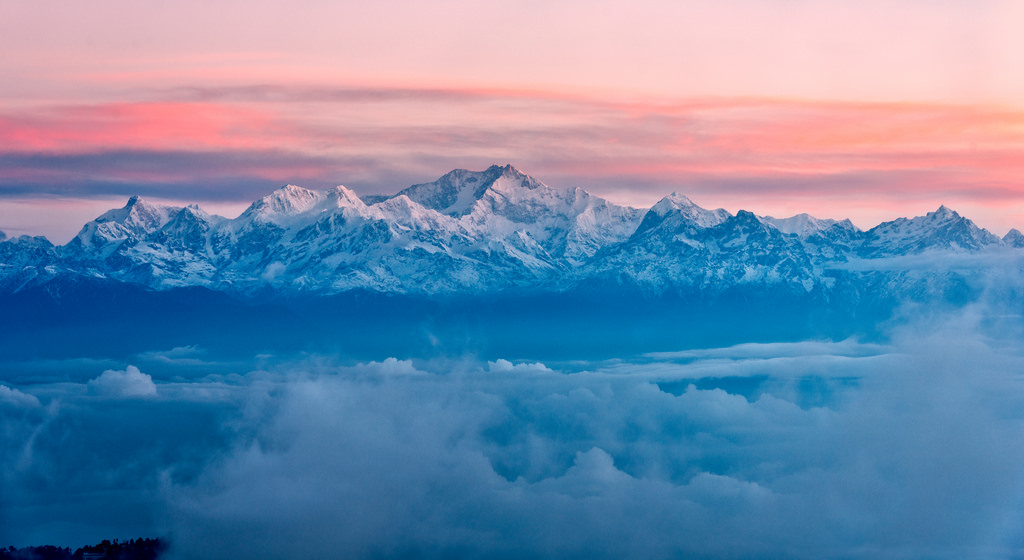
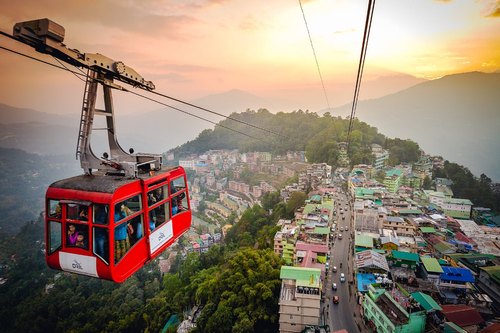
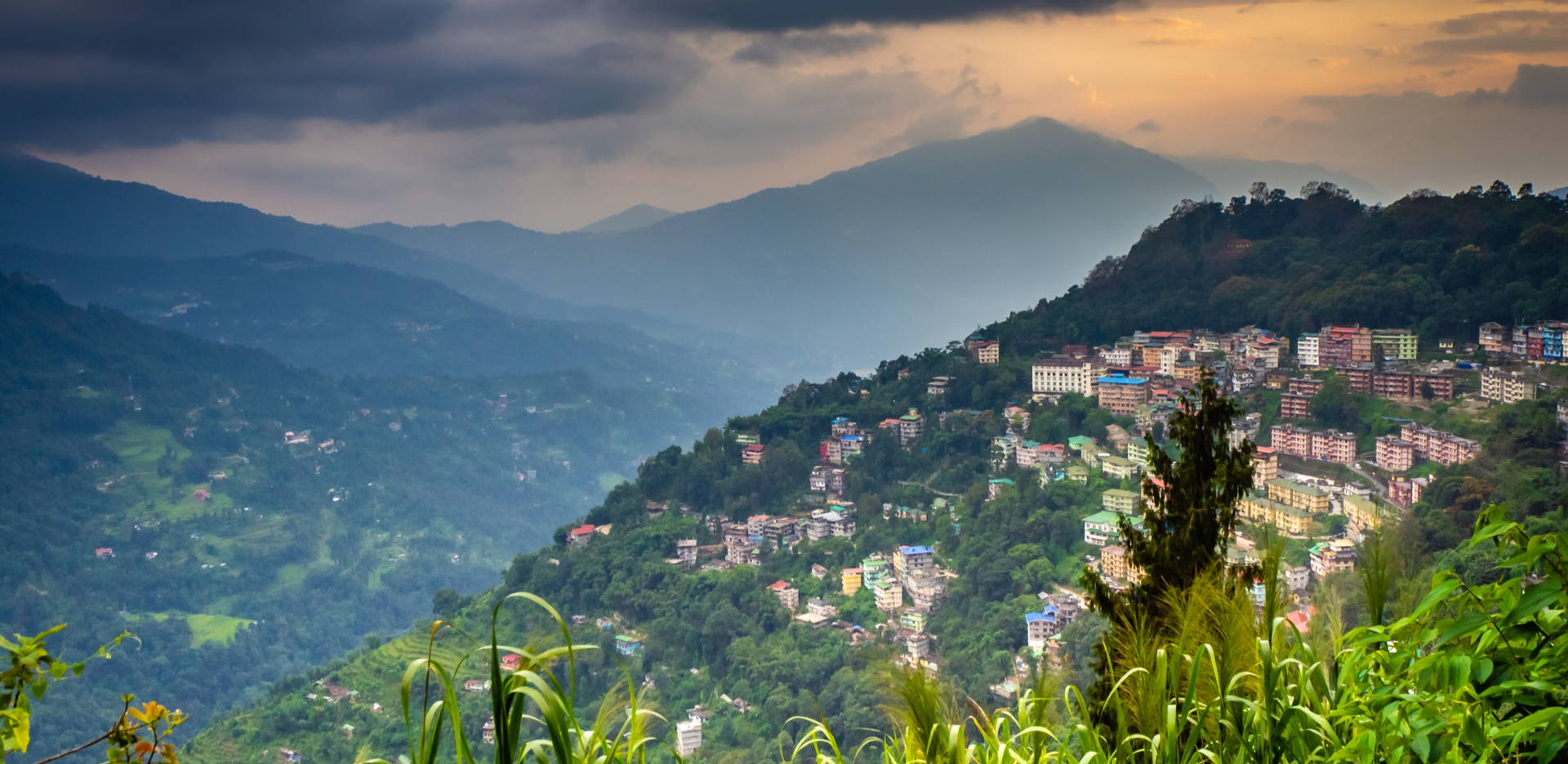
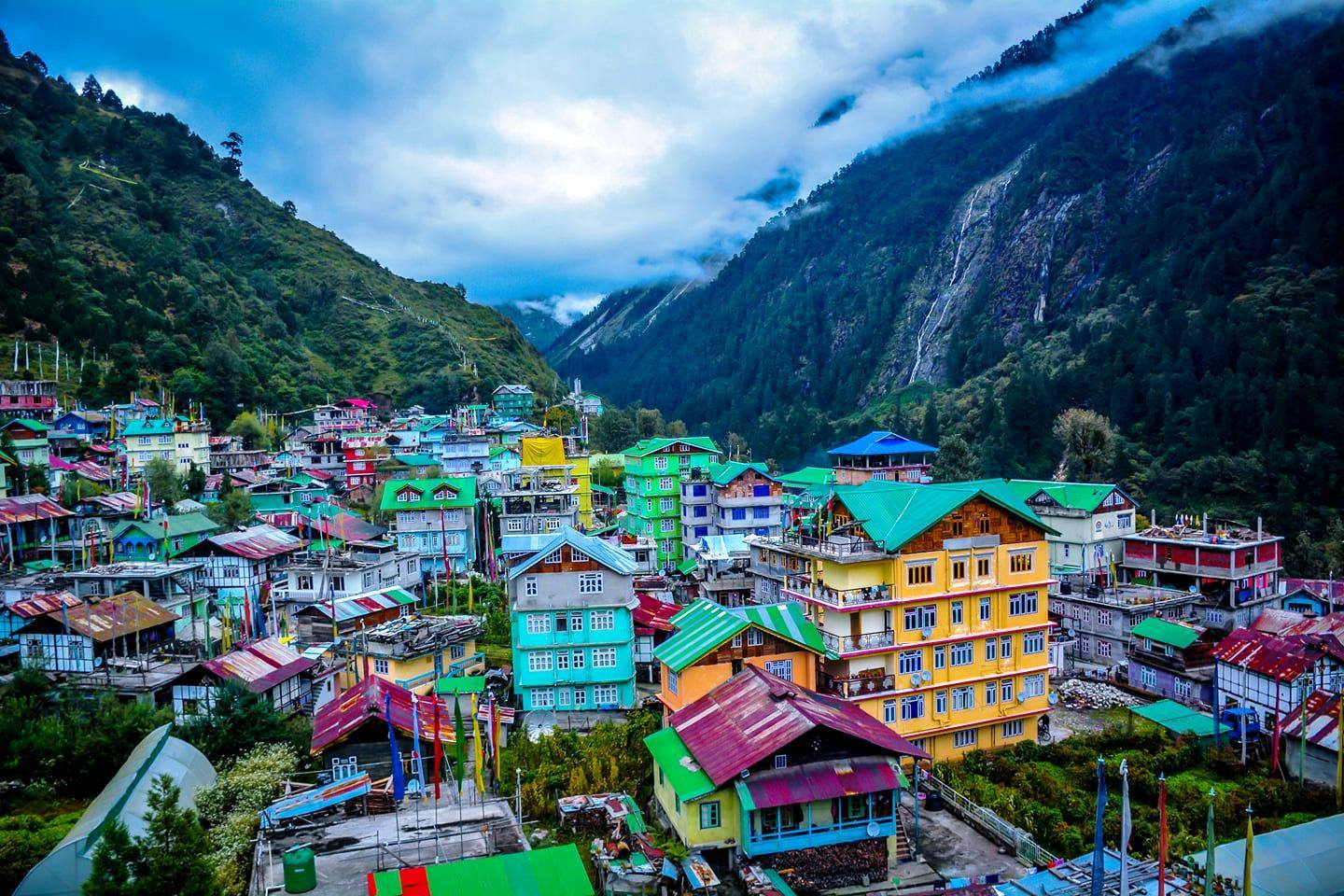
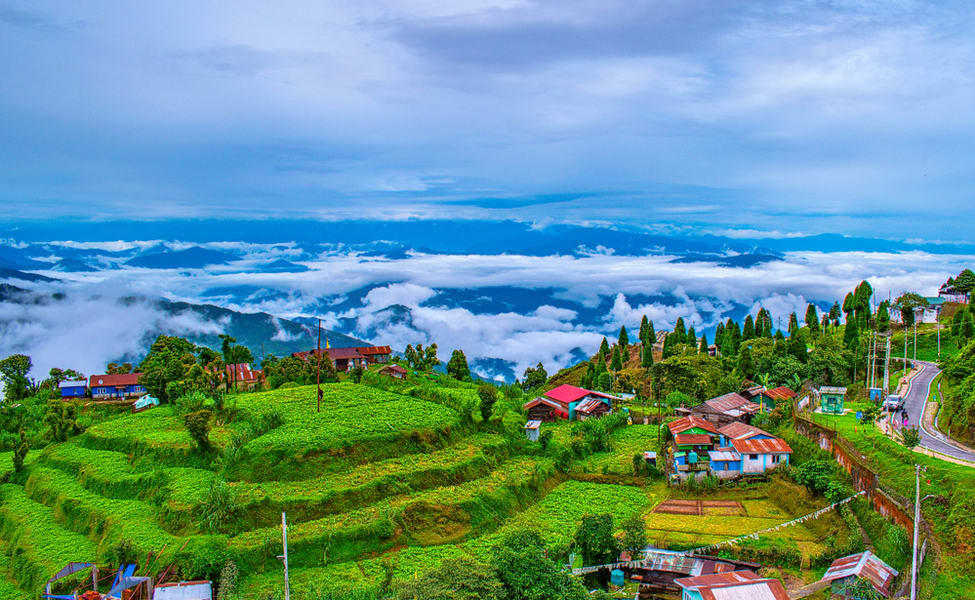





| Departure Dates | 2025: MAR 12, 26. APR 9, 16, 23, 30. MAY 7, 14, 21, 28. AUG 6, 13, 20, 27. SEP 3, 10, 24. OCT 15, 29. NOV 12, 26. 2026: MAR 11, 25. APR 8, 15, 22, 29. MAY 6, 13, 20, 27. AUG 5, 12, 19, 26. SEP 2, 9, 23. OCT 14, 28. NOV 11, 25. |
|---|---|
| Tour Code | - |
| EX | Bengaluru airport |
| Vehicles Used | Vehicle Depends on Group size |
| Duration | 10 Nights / 11 Days |
| States/Countries Visited | Sikkim, West Bengal |
| Places Visited | Kalimpong, Gangtok, Tsomgo Lake, Lachung,Yumthang, Namchi Chardham, Pelling, Darjeeling |
| Best Time To Visit | March to November |
DARJEELING
Darjeeling is a town in India's West Bengal
state, in the Himalayan foothills. Once a summer resort for the British Raj
elite, it remains the terminus of the narrow-gauge Darjeeling Himalayan
Railway, or “Toy Train,” completed in 1881. It's famed for the distinctive
black tea grown on plantations that dot its surrounding slopes. Its backdrop is
Mt. Kanchenjunga, among the world’s highest peaks.
At the time of the first British arrival,
Darjeeling was known among its Lepcha inhabitants
as Dorje-ling, or the "Place of the Thunderbolt.
According to the Oxford Concise Dictionary of World Place Names,
Darjeeling is derived from the Tibetan Dorje
ling or Dorje-glin, meaning "Land of Dorje," i.e. of the
thunderbolt, the weapon of the Hindu god Indra
Teesta, the major river of the Darjeeling
region, rises at 6,300 metres (20,700 ft) from a glacier in Sikkim, and
flows south, at first meeting the Rangpo river and then
the Rangeet before exiting the hills and eventually joining the Brahmaputra river in Bangladesh.
MIRIK
Mirik has become a tourist destination for
its climate, natural environment and easy accessibility. The centre of all
attraction is Sumendu Lake, surrounded by a garden
named Savitri Pushpaudyan (after Savitri Thapa, a martyr soldier
of INA) on one side and pine trees on the
other, linked together by an arching footbridge called Indreni
Pool (named after Indreni Thapa, a martyr soldier of INA). A 3.5-km-long
road encircles the lake and is used for walks with the view of Kangchenjunga on the far horizon. Boating
on the quaint boats and horse riding are available.
Mirik has an average elevation of
1,495 m (4,905 ft). The highest point is the Bokar Monastery at about
1,768 m (5,801 ft). Mirik lake at about 1,494 m (4,902 ft)
is the lowest point. Mirik is 52 km (32 mi) northwest of Siliguri city
and 49 km (30 mi) south-southwest of Darjeeling town. Mirik
subdivision. The name Mirik comes from the Lepcha words Mir-Yok meaning
"place burnt by fire".
NAMCHI CHARDHAM
Namchi chardham temple is located in south
sikkim amidst the mountains.The temple has replica of char dham Badrinath,
Rameshwaram, Dwarka, Jagganath along with twelve jyotilingas.Major attraction
of the place is Lord Shiva statue centrally located inside the temple.It
usually takes 2-3 hrs to visit the entire premises. Entire aura of the place
gives immense peace to one's soul.The place is must a visit.
PELLING
Pelling is a small town in the northeastern
Indian state of Sikkim, at the foothills of Mount Khangchendzonga. The
late-17th-century Buddhist Sanga Choling Monastery has mountain views.
Pemayangtse Monastery features wall paintings, sculptures and a gold-plated
statue of Guru Padsambhava. Overlooking a valley, the 17th-century Rabdentse
Palace, now in ruins, still has evidence of the king’s bedroom and kitchen.
Pelling, a beautiful town in the West
district of Sikkim, has become the second biggest tourist destination in Sikkim
after Gangtok. Located 10 km from Geyzing and 130 km from Gangtok, the main
attraction of the place is the breathtaking sight of the Khangchendzonga and
the neighbouring peaks
The famous Pemayangste monastery is less
than a kilometre from here and is a major tourist hotspot. Pelling also has
sites for mountain biking, rock climbing, village tours, meditations, apart
from serving as a base for a number of treks in the region. The scenic town of
Pelling is a perfect holiday destination for all nature lovers and adventure
enthusiasts.
Pelling, a beautiful petite town sited at a height of 6800ft was initially
covered with wild thick forest which served as home to many indigenous wild
animals of that period This ridge being situated in between two old Buddhist
monasteries (Pemayangtse and Sangacholing) developed into a full-fledged
village named Pelling. Today, Pelling is one of the best-chosen tourist
hotspots in Sikkim. More than that, Pelling is the heart where all the breathtaking
tourist spots of West Sikkim can be visited.
KANCHENJUNGA
The Kangchenjunga Himal section
of the Himalayas lies both in Nepal and India and encompasses 16 peaks over
7,000 m (23,000 ft). In the north, it is limited by the Lhonak
Chu, Goma Chu and Jongsang La, and in the east by the Teesta River. The
western limit runs from the Jongsang La down the Gingsang and Kangchenjunga
glaciers and the rivers of Ghunsa and Tamur.Kanchenjunga
rises about 20 km (12 mi) south of the general alignment of the Great
Himalayan range about 125 km (78 mi) east-southeast of Mount Everest . South of the southern
face of Kanchenjunga runs the 3,000–3,500-metre-high
(9,800–11,500 ft) Singalila
Ridge that separates Sikkim from Nepal and northern West Bengal.
Kangchenjunga, also
spelled Kanchenjunga,, is the third-highest mountain in the world.
Its summit lies at 8,586 m (28,169 ft) in a section of the Himalayas, the Kangchenjunga Himal, which is
bounded in the west by the Tamur
River, in the north by the Lhonak
River and Jongsang La, and in the east by the Teesta River It lies in the border region
between Nepal and Sikkim state
of India, with three of the five peaks, namely Main, Central and South,
directly on the border,[4] and the peaks West and Kangbachen in
Nepal's Taplejung
District
GANGTOK
Gangtok is the capital of the mountainous
northern Indian state of Sikkim. Established as a Buddhist pilgrimage site in
the 1840s, the city became capital of an independent monarchy after British
rule ended, but joined India in 1975. Today, it remains a Tibetan Buddhist
center and a base for hikers organizing permits and transport for treks through
Sikkim’s Himalayan mountain ranges
Gangtok
is a city, municipality, the capital and the most populous city of the
Indian state of Sikkim and also the headquarters of Gangtok District. Gangtok
is in the eastern Himalayan range, at an elevation of 1,650 m (5,410 ft). The
city's population of 100,000 consists of the three Sikkimese ethnicities the
Bhutias, Lepchas, Gorkhalis and also plainsmen from other states of India have
settled here. Within the higher peaks of the Himalayas and with a year-round
mild temperate climate, Gangtok is at the centre of Sikkim's tourism industry.
Gangtok rose to prominence as a popular
Buddhist pilgrimage site after the construction of the Enchey Monastery in
1840. In 1894, the ruling Sikkimese Chogyal, Thutob Namgyal, transferred the
capital to Gangtok. In the early 20th century, Gangtok became a major stopover
on the trade route between Lhasa in Tibet and cities such as Kolkata
TSOMGO LAKE EXCURSION
Sikkim is the 23rd state of India.
Gangtok, the capita; town of Sikkim is 24 km far from Bagdogra airport and it
takes 4 hours drive from there. Tsomgo Lake is 39 km from Gangtok and
situated at an elevation of 12,400 ft. This is one km long, 50 ft deep oval
shaped Lake with crystal clear water magnetize everyone. A 30 minutes drive to
Baba Harbhanjan Singh Memorial is in the 13,000 ft. height from the sea level
There are many interesting places to visit around Gangtok. The city sightseeing
to Ganjan Monastery, Ganesh Tok, Tashi View Point, Baktham Water Falls,
Lasa Water Falls, Handicraft Center, Flower Show are fabulous. The
panoramic view of Gangtok can be absorbed from the small Ganesha temple,
located at 6,500 ft.
LACHUNG
Lachung is a town and hill station in
northeast Sikkim, India. It is located in the North Sikkim district near the
border with Tibet.[1] Lachung is at an elevation of about 9,600 feet (2,900 m)
and at the confluence of the Lachen and Lachung Rivers, both tributaries of the
River Teesta. The word Lachung means "small pass". The town is
approximately 125 kilometres (78 mi) from the capital Gangtok.
The Indian Army has a forward base in the town. Before the Chinese occupation of Tibet in 1950, Lachung was a trading post between Sikkim and Tibet, after which it was closed down. The town's economy has been boosted by tourism in recent years as the region has been opened up by the Indian government. Tourists come from all over the world to visit the town between October and May, mostly on their way to the Yumthang Valley and the Lachung Monastery. Most of Lachung's inhabitants are of Lepcha and Tibetan descent. Languages spoken here are Nepali, Lepcha and Bhutia. During winter the town is usually covered in snow. Lachung is also the base camp for Rhododendron Valley Trek which starts from Yumthang Valley and ends at Lachen Valley
YUMTHANG
The Yumthang Valley or Sikkim Valley of
Flowers sanctuary, is a nature sanctuary with river, hot springs, yaks and
grazing pasture on rolling meadows surrounded by the Himalayan mountains in the
North Sikkim district of Sikkim state in India. It is at an elevation of 3,564
metres (11,693 ft) above msl at a distance of 150 kilometres (93 mi) from the
state capital Gangtok.
It is popularly known as 'Valley of Flowers'and is home to the Shingba Rhododendron Sanctuary, which has over twenty-four species of the rhododendron, the state flower. The flowering season is from late February and to mid June, when countless flowers bloom to carpet the valley in multicolored hues of rainbow.[4] A tributary of the river Teesta flows past the valley and the town of Lachung, the nearest inhabited centre. Yumthang is closed between December and March due to heavy snowfall. There is also a hot spring in the valley.
A forest rest house is the only permanent residence in the valley. During the spring months, the area blooms with rhododendrons, primulas, poppies, iris and other flora. During the summer months, villagers take their cattle to these heights to graze (a practice known as yaylag pastoralism). In view of increasing number of tourists, there is possibility of environmental degradation in near future.Skiing is conducted in the valley.
KALIMPONG
Kalimpong is a town and the headquarters of
an eponymous district in the Indian state of West Bengal. It is located at an
average elevation of 1,250 metres (4,101 ft) The town is the headquarters of
the Kalimpong district.The region comes under Gorkhaland Territorial
Administration which is an autonomous governing body within the state of West
Bengal. The Indian Army's 27 Mountain Division is located on the outskirts of
the city.Kalimpong is known for its educational institutions, many of which
were established during the British colonial period.It used to be a gateway in
the trade between Tibet and India before China's annexation of Tibet and the
Sino-Indian War. Kalimpong and neighbouring Darjeeling were major centres
calling for a separate Gorkhaland state in the 1980s, and more recently in
2010.The municipality sits on a ridge overlooking the Teesta River and is a
tourist destination owing to its temperate climate, natural environment and
proximity to popular tourist locations in the region. Horticulture is important
to Kalimpong: It has a flower market notable for its wide array of orchids;
nurseries, which export Himalayan grown flower bulbs, tubers and rhizomes,
contribute to the economy of Kalimpong. The Tibetan Buddhist monastery Zang
Dhok Palri Phodang holds a number of rare Tibetan Buddhist scriptures.The
Kalimpong Science Centre, established under the Darjeeling Gorkha Hill Council
in 2008 is a recent addition to its many tourist attractions. The Science
Centre, which provides for scientific awareness among the students of the town
and the locals sits atop the Deolo Hill.
A/C Reserved Vehicle for Airport Transfer & sightseeing as per itinerary.
Inner line permits.
Accommodation in 3*/4* category hotel / Resort on twin / Triple sharing basis with Taxes.
Breakfast & Dinner on fixed menu basis with taxes.
Vehicle with toll, Tax, Parking, Driver allowance, Night halt charges etc.
Sightseeing as per Itinerary.
Pre-departure assistance.
Complimentary insurance
Entrance tickets to monuments , museums, Boating , Yalk riding etc
Any insurance
5% GST
Excess baggage charge
Personal expenses
Increases in airfares or Government imposed taxes
Services not specifically stated in the itinerary & Anything not in cost Includes
Bengaluru - Bagdogra - Bengaluru air Tickets
Complimentary insurance is up to 80 years of Age and Above 80 years insurance premium will as per the insurance company policy
NOTE: This tentative itinerary is for your reference only. Final itinerary will be issued only after the confirmation of Air tickets/Hotel Bookings.
Bengaluru - Bagdogra - Bengaluru Airfare ₹ 13,500 /- approximately.
Insurance is complimentary and
Adigas Yatra is only the service provider, and all claims and settlements will
be settled by the Insurance company as per IRDAI rules and regulations.
1 Hand bag
1 Cap
| Departure Dates | 2025: MAR 12, 26. APR 9, 16, 23, 30. MAY 7, 14, 21, 28. AUG 6, 13, 20, 27. SEP 3, 10, 24. OCT 15, 29. NOV 12, 26. 2026: MAR 11, 25. APR 8, 15, 22, 29. MAY 6, 13, 20, 27. AUG 5, 12, 19, 26. SEP 2, 9, 23. OCT 14, 28. NOV 11, 25. |
|---|---|
| Tour Code | - |
| EX | Bengaluru airport |
| Vehicles Used | Vehicle Depends on Group size |
| Duration | 10 Nights / 11 Days |
| States/Countries Visited | Sikkim, West Bengal |
| Places Visited | Kalimpong, Gangtok, Tsomgo Lake, Lachung,Yumthang, Namchi Chardham, Pelling, Darjeeling |
| Best Time To Visit | March to November |
| Category | Price |
|---|
DARJEELING
Darjeeling is a town in India's West Bengal
state, in the Himalayan foothills. Once a summer resort for the British Raj
elite, it remains the terminus of the narrow-gauge Darjeeling Himalayan
Railway, or “Toy Train,” completed in 1881. It's famed for the distinctive
black tea grown on plantations that dot its surrounding slopes. Its backdrop is
Mt. Kanchenjunga, among the world’s highest peaks.
At the time of the first British arrival,
Darjeeling was known among its Lepcha inhabitants
as Dorje-ling, or the "Place of the Thunderbolt.
According to the Oxford Concise Dictionary of World Place Names,
Darjeeling is derived from the Tibetan Dorje
ling or Dorje-glin, meaning "Land of Dorje," i.e. of the
thunderbolt, the weapon of the Hindu god Indra
Teesta, the major river of the Darjeeling
region, rises at 6,300 metres (20,700 ft) from a glacier in Sikkim, and
flows south, at first meeting the Rangpo river and then
the Rangeet before exiting the hills and eventually joining the Brahmaputra river in Bangladesh.
MIRIK
Mirik has become a tourist destination for
its climate, natural environment and easy accessibility. The centre of all
attraction is Sumendu Lake, surrounded by a garden
named Savitri Pushpaudyan (after Savitri Thapa, a martyr soldier
of INA) on one side and pine trees on the
other, linked together by an arching footbridge called Indreni
Pool (named after Indreni Thapa, a martyr soldier of INA). A 3.5-km-long
road encircles the lake and is used for walks with the view of Kangchenjunga on the far horizon. Boating
on the quaint boats and horse riding are available.
Mirik has an average elevation of
1,495 m (4,905 ft). The highest point is the Bokar Monastery at about
1,768 m (5,801 ft). Mirik lake at about 1,494 m (4,902 ft)
is the lowest point. Mirik is 52 km (32 mi) northwest of Siliguri city
and 49 km (30 mi) south-southwest of Darjeeling town. Mirik
subdivision. The name Mirik comes from the Lepcha words Mir-Yok meaning
"place burnt by fire".
NAMCHI CHARDHAM
Namchi chardham temple is located in south
sikkim amidst the mountains.The temple has replica of char dham Badrinath,
Rameshwaram, Dwarka, Jagganath along with twelve jyotilingas.Major attraction
of the place is Lord Shiva statue centrally located inside the temple.It
usually takes 2-3 hrs to visit the entire premises. Entire aura of the place
gives immense peace to one's soul.The place is must a visit.
PELLING
Pelling is a small town in the northeastern
Indian state of Sikkim, at the foothills of Mount Khangchendzonga. The
late-17th-century Buddhist Sanga Choling Monastery has mountain views.
Pemayangtse Monastery features wall paintings, sculptures and a gold-plated
statue of Guru Padsambhava. Overlooking a valley, the 17th-century Rabdentse
Palace, now in ruins, still has evidence of the king’s bedroom and kitchen.
Pelling, a beautiful town in the West
district of Sikkim, has become the second biggest tourist destination in Sikkim
after Gangtok. Located 10 km from Geyzing and 130 km from Gangtok, the main
attraction of the place is the breathtaking sight of the Khangchendzonga and
the neighbouring peaks
The famous Pemayangste monastery is less
than a kilometre from here and is a major tourist hotspot. Pelling also has
sites for mountain biking, rock climbing, village tours, meditations, apart
from serving as a base for a number of treks in the region. The scenic town of
Pelling is a perfect holiday destination for all nature lovers and adventure
enthusiasts.
Pelling, a beautiful petite town sited at a height of 6800ft was initially
covered with wild thick forest which served as home to many indigenous wild
animals of that period This ridge being situated in between two old Buddhist
monasteries (Pemayangtse and Sangacholing) developed into a full-fledged
village named Pelling. Today, Pelling is one of the best-chosen tourist
hotspots in Sikkim. More than that, Pelling is the heart where all the breathtaking
tourist spots of West Sikkim can be visited.
KANCHENJUNGA
The Kangchenjunga Himal section
of the Himalayas lies both in Nepal and India and encompasses 16 peaks over
7,000 m (23,000 ft). In the north, it is limited by the Lhonak
Chu, Goma Chu and Jongsang La, and in the east by the Teesta River. The
western limit runs from the Jongsang La down the Gingsang and Kangchenjunga
glaciers and the rivers of Ghunsa and Tamur.Kanchenjunga
rises about 20 km (12 mi) south of the general alignment of the Great
Himalayan range about 125 km (78 mi) east-southeast of Mount Everest . South of the southern
face of Kanchenjunga runs the 3,000–3,500-metre-high
(9,800–11,500 ft) Singalila
Ridge that separates Sikkim from Nepal and northern West Bengal.
Kangchenjunga, also
spelled Kanchenjunga,, is the third-highest mountain in the world.
Its summit lies at 8,586 m (28,169 ft) in a section of the Himalayas, the Kangchenjunga Himal, which is
bounded in the west by the Tamur
River, in the north by the Lhonak
River and Jongsang La, and in the east by the Teesta River It lies in the border region
between Nepal and Sikkim state
of India, with three of the five peaks, namely Main, Central and South,
directly on the border,[4] and the peaks West and Kangbachen in
Nepal's Taplejung
District
GANGTOK
Gangtok is the capital of the mountainous
northern Indian state of Sikkim. Established as a Buddhist pilgrimage site in
the 1840s, the city became capital of an independent monarchy after British
rule ended, but joined India in 1975. Today, it remains a Tibetan Buddhist
center and a base for hikers organizing permits and transport for treks through
Sikkim’s Himalayan mountain ranges
Gangtok
is a city, municipality, the capital and the most populous city of the
Indian state of Sikkim and also the headquarters of Gangtok District. Gangtok
is in the eastern Himalayan range, at an elevation of 1,650 m (5,410 ft). The
city's population of 100,000 consists of the three Sikkimese ethnicities the
Bhutias, Lepchas, Gorkhalis and also plainsmen from other states of India have
settled here. Within the higher peaks of the Himalayas and with a year-round
mild temperate climate, Gangtok is at the centre of Sikkim's tourism industry.
Gangtok rose to prominence as a popular
Buddhist pilgrimage site after the construction of the Enchey Monastery in
1840. In 1894, the ruling Sikkimese Chogyal, Thutob Namgyal, transferred the
capital to Gangtok. In the early 20th century, Gangtok became a major stopover
on the trade route between Lhasa in Tibet and cities such as Kolkata
TSOMGO LAKE EXCURSION
Sikkim is the 23rd state of India.
Gangtok, the capita; town of Sikkim is 24 km far from Bagdogra airport and it
takes 4 hours drive from there. Tsomgo Lake is 39 km from Gangtok and
situated at an elevation of 12,400 ft. This is one km long, 50 ft deep oval
shaped Lake with crystal clear water magnetize everyone. A 30 minutes drive to
Baba Harbhanjan Singh Memorial is in the 13,000 ft. height from the sea level
There are many interesting places to visit around Gangtok. The city sightseeing
to Ganjan Monastery, Ganesh Tok, Tashi View Point, Baktham Water Falls,
Lasa Water Falls, Handicraft Center, Flower Show are fabulous. The
panoramic view of Gangtok can be absorbed from the small Ganesha temple,
located at 6,500 ft.
LACHUNG
Lachung is a town and hill station in
northeast Sikkim, India. It is located in the North Sikkim district near the
border with Tibet.[1] Lachung is at an elevation of about 9,600 feet (2,900 m)
and at the confluence of the Lachen and Lachung Rivers, both tributaries of the
River Teesta. The word Lachung means "small pass". The town is
approximately 125 kilometres (78 mi) from the capital Gangtok.
The Indian Army has a forward base in the
town. Before the Chinese occupation of Tibet in 1950, Lachung was a trading post between Sikkim and Tibet,
after which it was closed down. The town's economy has been boosted by tourism
in recent years as the region has been opened up by the Indian government.
Tourists come from all over the world to visit the town between October and
May, mostly on their way to the Yumthang Valley and the Lachung Monastery. Most
of Lachung's inhabitants are of Lepcha and Tibetan descent. Languages spoken
here are Nepali, Lepcha and Bhutia. During winter the town is usually covered
in snow. Lachung is also the base camp for Rhododendron Valley Trek which
starts from Yumthang Valley and ends at Lachen Valley
YUMTHANG
The Yumthang Valley or Sikkim Valley of
Flowers sanctuary, is a nature sanctuary with river, hot springs, yaks and
grazing pasture on rolling meadows surrounded by the Himalayan mountains in the
North Sikkim district of Sikkim state in India. It is at an elevation of 3,564
metres (11,693 ft) above msl at a distance of 150 kilometres (93 mi) from the
state capital Gangtok.
It is popularly known as 'Valley of
Flowers'and is home to the Shingba Rhododendron Sanctuary, which has over
twenty-four species of the rhododendron, the state flower. The flowering season
is from late February and to mid June, when countless flowers bloom to carpet
the valley in multicolored hues of rainbow.[4] A tributary of the river Teesta
flows past the valley and the town of Lachung, the nearest inhabited centre.
Yumthang is closed between December and March due to heavy snowfall. There is
also a hot spring in the valley.
A forest rest house is the only permanent
residence in the valley. During the spring months, the area blooms with rhododendrons,
primulas, poppies, iris and other flora. During the summer months, villagers
take their cattle to these heights to graze (a practice known as yaylag
pastoralism). In view of increasing number of tourists, there is possibility of
environmental degradation in near future.Skiing is conducted in the valley.
KALIMPONG
Kalimpong is a town and the headquarters of
an eponymous district in the Indian state of West Bengal. It is located at an
average elevation of 1,250 metres (4,101 ft) The town is the headquarters of
the Kalimpong district.The region comes under Gorkhaland Territorial
Administration which is an autonomous governing body within the state of West
Bengal. The Indian Army's 27 Mountain Division is located on the outskirts of
the city.Kalimpong is known for its educational institutions, many of which
were established during the British colonial period.It used to be a gateway in
the trade between Tibet and India before China's annexation of Tibet and the
Sino-Indian War. Kalimpong and neighbouring Darjeeling were major centres
calling for a separate Gorkhaland state in the 1980s, and more recently in
2010.The municipality sits on a ridge overlooking the Teesta River and is a
tourist destination owing to its temperate climate, natural environment and
proximity to popular tourist locations in the region. Horticulture is important
to Kalimpong: It has a flower market notable for its wide array of orchids;
nurseries, which export Himalayan grown flower bulbs, tubers and rhizomes,
contribute to the economy of Kalimpong. The Tibetan Buddhist monastery Zang
Dhok Palri Phodang holds a number of rare Tibetan Buddhist scriptures.The
Kalimpong Science Centre, established under the Darjeeling Gorkha Hill Council
in 2008 is a recent addition to its many tourist attractions. The Science
Centre, which provides for scientific awareness among the students of the town
and the locals sits atop the Deolo Hill.
| Day 1: Bangalore - Bagdogra Airport - Kalimpong (about 75 Kms / 3 Hrs) |
|---|
| Meet & Greet on arrival at Bagdogra Airport & transfer to Kalimpong (3,950 ft.). On arrival Check-in to hotel & rest of the day at leisure. Overnight stay will be at Kalimpong. |
| Day 2: Kalimpong Sightseeing - Gangtok (75 Kms / 3 Hrs) |
| After breakfast half day city tour of Kalimpong Visit Mangal Dham, Deolo Hill, Dr. Graham's Home, Golf Garden, Durpin Dara Hills & Pine View Nursery. Then transfer to Gangtok (3,950 ft.). On arrival check-in to your hotel. Overnight stay at Gangtok. |
| Day 3: Excursion To Tsomgo Lake & Baba Mandir |
| After breakfast start for an excursion to Tsomgo Lake (12,400 ft.) & Baba Mandir (13,200 ft.) which is 55 kms one way from Gangtok city. Overnight stay at Gangtok. (In case of Land slide or any other reason Tsomgo Lake is closed we will provide alternate sightseeing.) |
| Day 4: Gangtok - Lachung (103 Kms / 6 Hrs) |
| After breakfast check out from hotel with limited luggage and proceed to Lachung (8,700 ft.), North Sikkim. On the way take a break for some beautiful spots which are worth seeing and visiting like Naga Waterfall, The Confluence of Lachen Chu (River) & Lachung Chu (River) at Chungthang and Bhim Nala Waterfall. On arrival at Lachung check into your hotel. Dinner & Overnight stay at Lachung. |
| Day 5: Lachung - Yumthang Valley Excursion |
| After breakfast drive to Yumthang Valley (12,000 ft. Known as Valley of Flowers). On the way back, visit Hot Spring considered to have medicinal properties. After noon back to Gangtok. Overnight stay at Gangtok. |
| Day 6: Gangtok Local Sight Seeing |
| Start for a Full day city tour covering Tashi view point, Ganesh Tok, Hanuman Tok, Flower show, Cottage Industry and Handicraft Centre, Institute of Tibetology, Dro-dul Chorten, Enchey Monastery & Banjakhri Falls (maximum 6 hours). Overnight stay at Gangtok. |
| Day 7: Gangtok - Pelling (150 Kms / 5 Hrs) Via Chardham |
| After breakfast start for Pelling (6,300 ft.). Enroute visit Samdruptse & Siddheshwar Dham (Chardham) in Namchi. On arrival check-in to your hotel. Overnight stay at Pelling. |
| Day 8: Pelling Sightseeing |
| After breakfast start for full day sightseeing. 1st Half tour Darap village, Rimbi water Falls, Khecheopalri Lake & Khangchendzongha waterfalls. In afternoon start for 2nd Half tour Pemayangtse Monastery, Sang-Ngag Choling (Sky Walk at your own cost), New Helipad Ground. Overnight stay at Pelling. |
| Day 9: Pelling - Darjeeling (80 Kms /4 Hrs) |
| This morning after breakfast transfer to Darjeeling (6,950 ft.) via Singla check post. On arrival check-in to your hotel & rest of the day at leisure. Overnight stay at Darjeeling. |
| Day 10: Darjeeling Sightseeing |
| Early Morning (at 04:00 am) drive to Tiger hill (8,400 ft.) to watch the spectacular sunrise over Mt. Khangchendzongha (28,208 ft. Worlds 3rd highest peak), on your way back visit Ghoom Monastery and Batasia Loop. After breakfast visit Himalayan Mountaineering Institute, P.N. Zoological Park (Thursday closed), Tenzing Rock, Tibetan Refugee self-help Centre (Sunday closed), Tea Garden (outer view), Ropeway and Japanese Temple (Peace Pagoda). Evening free for shopping or leisure. Overnight stay at Darjeeling. |
| Day 11: Darjeeling - Bagdogra Airport (75 Kms / 3 Hrs) Back To Bangalore. |
| After breakfast Check-out from hotel and take the departure transfers to Bagdogra Airport. |
A/C Reserved Vehicle for Airport Transfer & sightseeing as per itinerary.
Inner line permits.
Accommodation in 3*/4* category hotel / Resort on twin / Triple sharing basis with Taxes.
Breakfast & Dinner on fixed menu basis with taxes.
Vehicle with toll, Tax, Parking, Driver allowance, Night halt charges etc.
Sightseeing as per Itinerary.
Pre-departure assistance.
Complimentary insurance
Entrance tickets to monuments , museums, Boating , Yalk riding etc
Any insurance
5% GST
Excess baggage charge
Personal expenses
Increases in airfares or Government imposed taxes
Services not specifically stated in the itinerary & Anything not in cost Includes
Bengaluru - Bagdogra - Bengaluru air Tickets
Complimentary insurance is up to 80 years of Age and Above 80 years insurance premium will as per the insurance company policy
1 Hand bag
1 Cap
NOTE: This tentative itinerary is for your reference only. Final itinerary will be issued only after the confirmation of Air tickets/Hotel Bookings.
Bengaluru - Bagdogra - Bengaluru Airfare ₹ 13,500 /- approximately.
Insurance is complimentary and
Adigas Yatra is only the service provider, and all claims and settlements will
be settled by the Insurance company as per IRDAI rules and regulations.